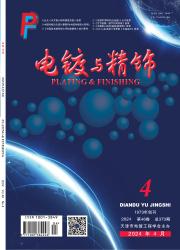
Doping effects on the electro-degradation o
With the development of chemical industry,large amounts of various organic compounds are discharged into the was usually found in polluted steams and a toxic organic compound,phenol can damage fish even in a concentration level of 2 mg·L-1[1].Phenol has been listed on the top among the pollutants which required treatment by the United States Environmental Protection Agency[2,3].Therefore,it was commonly used as the typical pollutant for the investigation of wastewater treatments[4].
To remove phenolic pollutants from waste water,a large number of methods have been developed,including adsorption,oxidization and biodegradation[4].Electrochemical oxidization approach has attracted much attention due to its easy management and less secondary pollution[5–7].Boron-doped diamond(BDD)electrodes[8,9]and Ir/Ru modi fied dimensionally stabilized anodes(DSAs)[1,10]have been reported to be effective for some organic compound ,the high price of diamond film and Ir/Ru materials limited their applications.
The titanium suboxide(Ti n O2n-1 3<n<10)have perfect electrical conductivity and chemical has attracted much interest since the 1990s as the major compound in electrochemical electrodes to well deal with polluted water and to use as the bipolar electrodes due to the best conductivity[11,12].However,it is difficult to prepare pure Ti4O7 by reducing TiO2 because of the very narrow Gibbs energy gap from Ti3O5 to Ti4O7,and then to Ti5O9[13].Recently,bene fiting from a novel co-deposited route,tons of pure Ti4O7 powders(phase purity>99%)can be produced in our cooperation provided the possibility to compare the efficiency of phenol degradation on the pure Ti4O7 anode and the traditional mixed Ti n O2n-1 addition,doped titanium suboxide electrode was rarely investigated although doping is the most popular strategy to modify semi-conductive materials.
The doping reagentof Gallium and Yttrium has been reported to enhance the conductivity and photodegradation activity of TiO2 material due to the reduced energy gap[14,15].Inspired by these works,the doping effects to titanium suboxide were investigated in this differences were carefully studied for the electro-degradation of phenol in Na2SO4 solutions on the anodes of pure Ti4O7,the mixedcrystal Ti4O7 and Ti5O9(labeled as Ti4O7–Ti5O9),the Y-doped Ti4O7,and the Ga-doped oxygen demand(COD)was measured to evaluate the electro-oxidation apparentkinetics and cumulative current efficiency(CE)were calculated based on the COD.The intermediates in the experiments were identified by HPLC to reveal the degradation results implied that the phenol was oxidized to oxalate molecules via different routes on different doped anode surfaces,and finally oxidized thoroughly to CO2 and H2O.The mechanisms were proposed at the end.
Pure Ti4O7 powder and the Ti4O7–Ti5O9 mixed-crystal powder were obtained from the Shandong League Chemical Group Co.,Ltd.(China).The powder sizes were+180 mesh(<80 μm).The doping reagents(Y2O3 and Ga2O3)were of analysis grade purchased from Sinopharm Chemical Reagent Beijing Co., power was purchased from Hangzhou Sumengte Company.
Authentic substances were purchased from Sinopharm Chemical ReagentBeijing Co.Ltd.,including pyrocatechol,hydroquinone,benquinone oxalate,formic acid,maleic acid and α-ketoglutaric acid.
and characterization
0.5 g doping reagent was mixed with 100 g Ti4O7 the mixtures,the pure Ti4O7 powder,and the Ti4O7–Ti5O9 powder were mixed with 10 wt%of polyimide powder, mixture was compressed at 200 MPa in a 7.5 cm×12.6 cm mold and then was heated at 170°C for an cooling down,the plates were taken out from the mold and were calcined under Ar flow in 1273 K.The finalplates played as the anodes in degradation,which were labeled as Y-doped Ti4O7,Ga-doped Ti4O7,Ti4O7 and Ti4O7–Ti5O9,respectively.
The X-ray diffractions(XRD)were performed on an Empyrean X-ray diffractometer with monochromatic CuKa radiation(λ=1.5418 nm).The step-scan covered the angular range from 5°to 90°at a scan rate of 1.5(°)·min-1 using silicon as internal XRD peaks were re fined by using the Highscore plus software and fitted by the Rietveld function to estimate the phase morphologies were observed by using the SEMmode on a MineralLiberation Analyzer(FEI MLA 250).The EDX was performed on the same.
degradation
The electro-degradation of phenol was performed in a 500 ml glass beaker with magnetic initial solution consisted of 0.1 mol·L-1 Na2SO4 and 1.04 mmol·L-1 phenol.A titanium plate and the titanium suboxide anode were immersed into the solution with a 4 cm gap.
Chemical oxygen demand(COD)was determined by the fast digestion spectrophotometric method[16].The current efficiency(CE)for COD decline was calculated using the following equation:
The concentration of phenol and possible intermediates was measured by HPLC with an ACQUITY UPLC BEH C18 column and MS/UV–vis methanol was used to clean the species of intermediates were identified by HPLC-MS with pure water as the mobile phase.A UV–vis detector was utilized to determinate the retention time and the later case,90 ml methanol and 10 ml of 1 mmol·L-1 H3PO4 aqueous solution were mixed to be the mobile phase.
下一篇:没有了
